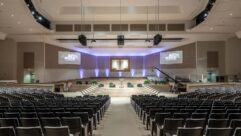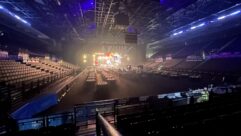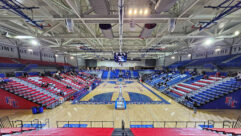Stage Presence
Nov 1, 1998 12:00 PM,
Jack McLean
Acoustically and architecturally, the main theater at the Viterbo CollegeFine Arts Center possesses an uncommon splendor now matched by a new soundreinforcement system tailored to the room’s requirements. Located on the LaCrosse, WI, campus of the college, the unique space accommodates drama,musicals, operas, ballet, concerts-in short, an entire gamut of performingarts in addition to conferences and lectures.
Opened in 1971, the room designed by George C. Izenour Associates isheadlined by a system of movable ceiling panels that allow tailoring toaudience size and performance needs quickly. From a capacity of 1,123seats, sections of the solid and perforated panels on “spider web” gridscan be lowered in a matter of minutes to trim the seat count to 748 or 535with basically the same acoustic signature. The addition of a speciallydesigned acoustical shell converts the room into a concert hall. Meanwhile,a sizable orchestra pit can be raised from a sublevel into a position ofprominence at the front of the stage.
Based upon its proven track record on several projects throughout the area,Professional Audio Designs, Wauwatosa, WI, headed by Scott Leonard and KimDeSpears, was asked last year to supply the college with a design andinstallation proposal for a new sound reinforcement system. Leonard andDeSpears worked closely with Scott Hawley, production coordinator at thecollege, applying his hands-on knowledge of the theater and combining itwith their own experience to create a well-balanced plan that would meetbudgetary, ease-of-use, flexibility and performance requirements. Anotherprimary design factor-aesthetics. Any proposed system would need to makeminimal visual impact upon the theater.
Valuable insightIn a nutshell, the previous system was outdated, particularly in meetingincreasingly sophisticated modern performance demands. An under-whelmingcenter loudspeaker cluster had been augmented by two full-rangeloudspeakers flown about halfway into the house without time delay. Mostother system components showed their advancing age as well, and the systemwas incapable of adequately accommodating the needs of touring productions.Rental systems had proveda somewhat effective short-term solution. In fact,during the design and implementation process, Pro Audio Designs supplied arental system based upon Eastern Acoustic Works’ (EAW) KF seriesloudspeakers, a situation that worked so well that it heightened theclient’s confidence in the proposed design, which also featured EAWloudspeakers.
Providing the rental system also offered valuable insight into the room’sacoustic signature. Although the design team had an opportunity to take alook at some past acoustical data gathered, bringing in the rental systemallowed them to make a thorough evaluation by listening to how soundreacted in the room. In addition, Pro Audio Designs’ regular use of EAWloudspeaker systems provided a good frame of reference as to what to expect.
“I guess it looks good if you bring out a bunch of test gear and take tonsof measurements,” Leonard explained. “But sometimes, as was the case here,you just know what’s going to happen, so our test gear pretty much stayedon the shelf.”
The essence of the design from an electro-acoustical standpoint involvedfocusing energy as tightly as possible on the seating and off side and backwalls. A rather broad face on the front of the first balcony presented thepotential for sound to slap back to the stage, a characteristic thatfurther highlighted the need for loudspeakers with tight pattern control.In this same vein, the extension of the orchestra pit toward the audiencemeant that loudspeakers in the stage region should minimize off-axisspillage.
During this process, Leonard discussed the qualities of the room and therequirements of the design with Stephen Siegel, EAW’s application supportgroup manager. Ultimately, Siegel paid a visit to the theater, offering hisinput as well as information regarding a recently completed EAWloudspeaker. Called the MH660DF, it is a hybrid of the EAW MH660 (popularin performing arts applications) that includes a special downfiring section(hence the “DF” designation in the model number). Another high-frequencysection was added to the bottom of the cabinet, maintaining the samecoverage pattern as the rest of the two-way system but firing downward atapproximately 40 degrees.
The decision boiled down to a central loudspeaker cluster, flown above thefront lip of the stage and knit within the fabric of the acoustical panelswith two MH660DF loudspeakers flanking a single EAW TD412 low-frequencymodule, which was selected because of its tight low-frequency directivityin the vertical plane, thus addressing the concern about keeping energylevels in the stage and pit areas low.
“The cluster covers up to the first section of the balcony with thedownfill horns covering the main floor seats,” Leonard said. “The low-endenergy, tight and steerable through the use of sophisticated digital signalprocessing, keeps things acceptably quiet on the stage.”
During installation, Pro Audio Designs removed some structural steel totuck the cluster into the ceiling. ATM Fly-Ware supplied a custom flybarthat supported a bridled hand point with 3/8 inch (9.5 mm) steel cable. Asection of ceiling panel was cut to bridge a gap between the cluster’s twomid/high loudspeakers. Attached to the bottom of the low-frequencyloudspeaker with “L” brackets, it not only effectively fills the gap, butit also blends the cluster with the ceiling.
“This makes the cluster seem more a part of the ceiling,” Leonard noted.”The client is happy with the way it turned out.”
There was no ideal place, either on the floor or flown above, for the twoEAW SB250 subwoofers. Some investigative work turned up two small shelfareas-one on each side of the prosce-nium about halfway up the walls-thatworked fairly well. Although not as efficient as placing the subwoofers onthe floor, their final location offers better overall distribution oflow-frequency energy, reaching to the back of the upper balcony.
“We tend to roll off a lot of the low-end in the delay loudspeakers becausewhen too many sources generate low-frequency energy in a relatively smallspace, it sounds unnatural,” Leonard explained. “The approach seemed to keepthis aspect well balanced with the rest of the system.”
Digital controlThe complexity of the center cluster design-cabinets with integral downfillhorns plus a steerable low-frequency section-required a complex six-waycrossover. Careful consideration of significant factors influencing thedesign led to the selection of two EVI Merlin ISP-100 digital signalprocessors located with the system’s Crest CA series power amps in asecured backstage room. Merlin provides EQ, delay, limiting and crossoverin a 1 RU unit. It supports the use of a maximum of five removable I/Omodules, either analog or digital, with multiple configuration options. Acustom software package allows selection of the signal processing path andcomplete control of multiple signal processing functions in real time,on-line or off-line.
Available standard with a 4 x 6 I/O configuration, Leonard specified one ofthe units be supplied with a 2 x 6 configuration. It is fed by an Oxmoordistribution amp that sends a mono output to the first two inputs of theMerlin. In normal left-right operation mode, input number one feeds thecluster, and input number two feeds the two subwoofers. The operator canalso feed the subwoofers independently by patching a drive line into inputnumber two. A preset was also established for times when the pit orchestraarea is in use, changing the level and EQ of the downfill section of thecluster.
The other Merlin unit, in standard configuration, controls three delaylines, two stage-lip loudspeakers and the control room monitors. Each delayline receives a summed mono feed and consists of six loudspeakerspositioned horizontally and concealed above the acoustical clouds. Eachloudspeaker’s mounting hardware connects to a threaded rod attached toUnistrut spanning support beams at the ceiling.
The first line, EAW JF80 compact two-way loudspeakers, cover the point inthe first balcony where cluster coverage tails off. Angled at a gentlebackfiring angle, they cover several rows until the next line, made up ofEAW JF60 compact two-ways, is feathered in. The third delay line, made upof EAW UB12 compact loudspeakers, bolsters coverage to the last seating row.
“We angled the first two rows to fire back because with delay systems, it’sdifficult to get sound to appear as though it’s coming from the stage. Ifyou’re firing them straight down, the effect can be detrimental,” Leonardsaid. “The caution, though, is not to angle them back too steeply becausethis can also yield undesirable results.”
To calculate delay settings, distances were measured from the cluster tothe respective delay loudspeaker positions, and this information wassubsequently entered into the Merlin’s digital delay. Fine tuning wasachieved through a combination of data supplied by a JBL SMAART system andcareful listening.
“Sometimes I’m not sure if the delay factor or ‘through delay’ of theprocessor itself is calculated as part of the equation,” Leonard noted.”It’s commonly said that if delay settings are within 30 ms or so, you’relikely OK, but I find that even small changes can alter the perception ofboth the sound’s frequency and its point of origin, so we try as best aspossible to take the slight delay occurring in the device intoconsideration during this process.”
An added benefit-the capability to connect a laptop via serial cable toeither Merlin easily and move around the auditorium, controlling all of theprocessing functions remotely to adjust and balance the system. Thissignificantly cut the time required to commission the system.
“At the end of a long day, there’s nothing like stretching out a serialcable to the mix position and controlling everything from there withoutrunning back and forth to the rack room,” said Leonard.
Clean powerA new AC power system was installed, with all power for the sound systemfed from its own isolation transformer. This includes outlets at a remotemix position in the balcony as well as all stage panels. There is also aclean power connect for visiting productions to use with their own stagemonitoring systems. Pro Audio Designs regularly specifies Crest power amps, andthis project was no exception. The CA series amps driving the system aresized according to their respective needs.
“Crest amps are reliable, sound good, and they’re cost effective,” DeSpearssaid. “The client inquired about other amp brands, but we demonstrated thatthey could get double the amount of power for roughly the same cost as someother amp manufacturers. That was good enough for them.”
The power amps, linked to a Lyntec power sequencer, can be activated at thepress of a button in the control room at the rear of the first level. Allamps are clearly labeled, so ones driving delay loudspeakers that might notbe needed for a given performance can simply be shut off or patched aroundat the control room.
A Whirlwind 52-channel, transformer-isolated split snake creates a flexiblebackbone for clean, simple routing, and the unit facilitates easytransition to the remote mix position, which is handy for musicalperformances. At the stage, there is a panel with 52 inputs and two returnsrunning via the snake to the control room panel outfitted with twoWhirlwind mass connectors. One panel is labeled “from microphones,” and theother panel is labeled “to remote mix.”
Insertion of a jumper between the two then provides routing to thealternative mix position. Another mass connector at this position allowsthe Soundcraft K2 mixing console to be plugged in along with a birch rackhousing processor that shuttles between the two mix positions. The rackincludes Klark Teknik DN360 EQs for tailoring the house system and aLexicon reverb and other effects devices.
“We included drive lines as part of this package as well, so it’s a prettyeasy changeover,” said DeSpears. “Being a college venue, inexperiencedstudents sometimes use the system, so simplicity was a must. Also, with thenumerous road shows coming in, we wanted to supply a snake system thatwould do whatever was needed without forcing the operators to drag extrasnakes through the house.”
Problem solvedDeSpears cited the cluster (with the specialized downfill loudspeakers) asthe most significant aspect of the project. Finding compact loudspeakerswith good pattern control and the ability to fit in a tight space was keyto conceiving and implementing a well-engineered system.
Viterbo College staff members agree. Recently, Scott Hawley sent a letterto Pro Audio Designs, praising the function and form of the new system.”This weekend we had our first real test of the system, and I must say thatit performed beyond expectation. This job required unique and difficultproblem solving to maintain the look and feel of our facility, and yourstaff put out extra effort to get things done right.”










